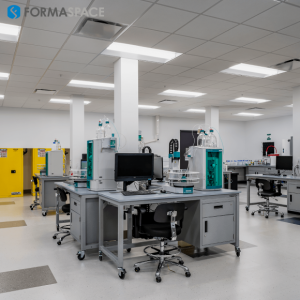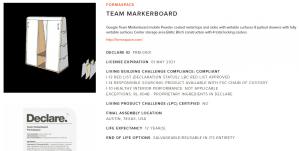How Carbon Neutral Manufacturing Has Become the New Gold Standard
Is your manufacturing company ready to become carbon neutral? Take a look at the steps you can take today to reduce your carbon footprint.
Not all manufacturing operations can be converted to renewable energy, however. Energy-intensive processes may need to use fossil fuel-based power for the foreseeable future.”
AUSTIN, TEXAS, UNITED STATES, September 29, 2020 /EINPresswire.com/ -- The year 2020 will be remembered as the year that Nature struck back.— Formaspace
As the novel Coronavirus pandemic has spread across the globe, we’ve also experienced a record-breaking Atlantic hurricane season that has brought widespread storm damage to the Gulf Coast. Meanwhile, the Western states of California, Oregon, and Washington have been blanketed with acrid smoke as massive wildfire conflagrations have burned out of control.
These unprecedented weather events are taking place at a time when the world’s average temperature has increased by 1°C since the start of the industrial revolution.
Given that climate scientists believe we are on track to double or triple this temperature increase within the lifetime of today’s youngest generations, it’s sobering to imagine the potential ecological destruction and misery we may suffer in the future unless we take drastic action to control greenhouse gas (GHG) emissions now.
Corporate America is beginning to take action.
According to one of the leading environmental consulting companies, Natural Capital Partners, nearly 25% of Fortune Global 500 companies have made a commitment to reduce their net greenhouse gas emissions to net-zero by 2030.
The number of major companies that have publicly committed to achieving this “carbon neutral” status is growing – from around 100 in 2019 to more than 200 today.
And the list keeps growing.
For example, Formaspace clients Ford Motor Company and Google have both recently announced plans to become carbon neutral. Apple, during its recent product introductions, pointed out that its new iPad Air will be carbon neutral, joining Microsoft, which previously announced its ambitious plans to go even further — to go “carbon negative” (e.g. remove more carbon from the atmosphere than it produces).
Meanwhile, Tesla, which is building a new electric truck manufacturing facility in Austin, has pledged carbon neutrality for its giant “Gigafactory” battery manufacturing operations, and oil and gas producer BP has recently committed to aggressive plans to reduce its carbon footprint.
How quickly will other manufacturers jump on the carbon-neutral bandwagon?
There are signs that we may soon reach a tipping point.
Leading-edge companies have already demonstrated it’s possible to go carbon neutral using today’s technology, and many have saved significant money on energy costs as a result.
Adding to the pressure, more consumers are making their purchasing decisions based on the environmental stance of companies they do business with. The same goes for business-to-business (B2B) transactions: as more and more companies pursue a carbon-neutral agenda, they are strongly motivated to purchase goods and services from other companies pursuing the same goals, to reduce the carbon footprint across their collective supply chains.
Finally, finance and government regulations are adding additional pressure on companies to make the switch toward carbon-neutral programs. Institutional investors are using the power of “investor activism” to encourage policies that are friendlier to the environment. In Europe, the EU has set forth a goal to be carbon neutral by 2050, and the state of California has announced its ambitious plans to be carbon neutral by 2045.
Conduct A Carbon Audit And Track Your Carbon Emissions “Budget”
What steps can your manufacturing company take today to reduce its carbon footprint and achieve the goal of becoming carbon neutral?
As with any other business initiative, the first step is to create an accurate baseline measurement of the “before” state, so you’ll have a wide-ranging understanding of exactly where you need to improve.
Tracking the monthly electric utility bill is no longer sufficient; instead, you will need to invest in new meters, sensors, and other devices to get a true understanding of every aspect of your current energy usage — as well as to accurately quantify any greenhouse gases emitted into the atmosphere during your production processes.
In addition to these so-called “direct emissions,” you will also need to identify and measure “indirect emissions” (such as those created by the power plant supplying electricity to the grid) as well as “indirect value chain emissions,” which span the gamut from the carbon emissions created by vendors supplying your raw materials to your customers who buy and use your products.
Keeping track of all this energy usage data is complicated, so don’t reinvent the wheel by trying to create a framework formula from scratch.
Instead, focus your efforts on collecting the data by leveraging one of the several environmental management system (EMS) frameworks adopted by other companies.
Popular EMS frameworks include the pioneering system developed by Natural Capital Partners back in 2002, the ISO 14000/14001 series of energy standards, as well as two standards developed in Europe: the Eco-Management and Audit Scheme (EMAS) and PAS 2060 from the British Standards Institution (BSI Group).
Most of the organizations offering environmental management system (EMS) frameworks are also in the business of offering carbon-neutral “certifications” once you meet your carbon-neutral goals.
Tip: Before you select an EMS framework, perform due diligence to determine which of the available certifications are the most well-regarded in your industry sector and make your final EMS selection based on that criteria. Once you commit to a specific EMS implementation, it stands to reason it will be far easier to get a “carbon neutral” certification from the same organization.
Change Up Energy Sources Powering Manufacturing Processes To Reduce Greenhouse Gas Emissions
When it comes to manufacturing companies, production processes tend to use the most energy, unlike other businesses, where heating and cooling buildings are typically the greatest energy users.
That’s why switching to renewable energy sources to power your production lines can have an outsized impact on reducing carbon emissions.
And there are a lot more environmentally friendly options available today. In many markets, you can choose electricity providers that use solar, wind, or other renewable energy sources. This can be supplemented with on-site power generation using solar arrays or wind turbines.
Not all manufacturing operations can be converted to renewable energy, however. Energy-intensive processes (such as blast furnaces used by metal manufacturing companies) may need to use fossil fuel-based power for the foreseeable future.
In these cases, adding an energy co-generation system makes sense. Co-generation systems can absorb any excess heat (which would otherwise go to waste) and use it for another purpose, such as generating steam to heat buildings, or powering other manufacturing processes, thus reducing the overall energy usage.
A Case For Energy Grid Micromanagement
Industrial power customers who are used to paying for cheap power during off-peak hours (such as at night) will need to rethink their approach to energy use management.
This is because wind and solar production peaks during the daylight hours, providing a surplus of available power during the middle of the day.
(This also means you may be able to negotiate with your utility company get the cheapest, cleanest electricity during the middle of the day.)
Electric grid operators describe this new phenomenon as the “duck curve” – a name given to the shape of the curve that results when you calculate the difference between consumer demand for electricity (which peaks in the early morning and again in the late afternoon) and the available supply of solar and wind energy (which peaks during the middle of the day).
Balancing between these two curves is tricky for grid operators. Without large scale energy storage systems, most grid operators need to be ready to “dispatch” power plants (typically powered by fossil fuels) very quickly, especially during the late afternoon demand peak, then throughout the night and into the morning peak period, after which, the solar and wind supplies become available again.
Suffice to say that managing the balance between these ever-changing supply and demand curves is a major challenge for grid operators (as well as manufacturing companies operating their own on-site solar or wind generation systems) – making it a task that is well suited for automated computer systems.
Sensing an emerging need, Google has created a new AI-based system (using its Deep Mind machine learning technology) that is capable of making micro-adjustments throughout the day to optimize energy. The new system was initially developed for Google’s own energy-intensive data centers, but the company has announced it intends to sell these AI-based energy management systems to other industrial users as well.
Reduce HVAC Energy Use With Smart LEED-Certified Buildings
The second biggest source of energy use in the manufacturing sector is heating and cooling the building. (For most other businesses, this is typically the number one energy user.)
Read more...
Julia Solodovnikova
Formaspace
+ +1 800-251-1505
email us here
Visit us on social media:
Facebook
Twitter
LinkedIn


